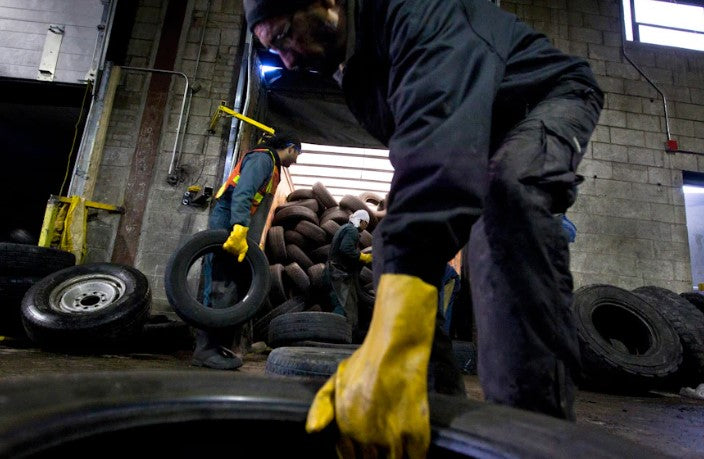
Recycle Right: What You Need to Know About End-Of-Life Batteries
Can you imagine a world without batteries? From your smartphone to your singing birthday card, these items would not exist without batteries. Needless to say, we’ve become quite dependent on batteries.
In fact, North Americans throw away 3.3 billion mixed batteries each year instead of recycling them. Across the globe, an estimated 30,000 tonnes of batteries are thrown away, and just 1,000 tonnes are recycled properly.
So, what should happen when batteries reach their end-of-life? They can and should be recycled responsibly. Here’s everything you need to know about recycling your end-of-life batteries:
Why recycle batteries?
Utilize non-virgin
materials.
Virgin materials refer to unused raw materials; non-virgin materials are materials regenerated from discarded products through the process of recycling. For example, lithium, nickel, and cobalt are mined as virgin materials to create batteries. The problem is that these are non-renewable resources, meaning that the natural resource will not regenerate as quickly as we need and, therefore, cannot be harvested sustainably.
However, these materials are infinitely recyclable. Battery recyclers are able to extract raw materials from used batteries and forward them to manufacturing companies for reuse. Battery recycling helps conserve resources while reducing the use of raw materials, the pollution emitted from mining, and the cost of new batteries.
Keep harmful chemicals
out of the environment.
Batteries contain elements like lead, mercury, and cadmium, which are known to be dangerous pollutants and hazardous to human health.
Batteries can release chemicals if they are damaged in the waste collection process or when they start corroding from sitting in a landfill. Once batteries begin to leak, their chemicals can seep into the earth or other materials, eventually contaminating our waterways or valuable recyclables.
Proper recycling is a safe
option.
From collections to Material Recovery Facilities (MRF), battery fires are an everyday risk to our staff in the waste management industry. When batteries reach 45-50°C, a chemical reaction causes them to become highly flammable and even explosive, significantly increasing the risk of starting a fire.
Batteries cannot be recycled in your curbside recycling program; instead, they need to be taken to an electronics recycler or municipal drop-off depot. Properly recycling batteries will protect waste management facilities from unnecessary shutdowns that cause service delays and, more importantly, protect our workers from fire-related injuries.

How do I dispose of end-
of-life batteries?
Throwing batteries in the garbage or recycling bin may seem easier than finding a drop-off depot but ensuring that we reap the benefits of battery recycling is easier than you may think.
Recycling loose, mixed batteries such as AAs and AAAs is simple and straightforward, but there are a few precautions you can take to make sure the recycling process is safe for you and your recycler.
When recycling rechargeable batteries, ensure any exposed terminals or wires are taped or bagged during storage and prior to recycling. For non-rechargeable batteries, it is recommended to tape their positive and negative terminals before recycling; this reduces the chances of battery ends touching and causing short-circuiting.
If you have damaged batteries, use protective gloves and eyewear to place them in a separate bag and mark that it contains broken batteries.
A growing number of Canadian retailers, such as Canadian Tire and IKEA, now offer in-store battery recycling programs.
If you’re in Ontario, Canada, you can search for your nearest collection point here.
So, how are batteries recycled?
According to Call2Recycle - the leading battery collection and recycling program across Canada – once batteries are collected, they are sorted based on weight and battery type, such as rechargeable or single-use.
Electronic recyclers can recover every component of the battery. For instance, our partners at E-Cycle in Mississauga, Ontario, use a combination of manual and mechanical processes to disassemble a device and sort it by material. Processors at the recycling plant extract chemicals and metals to be used in the manufacturing of new products. In this way, virtually all useful materials from your device are recovered.
Recycled materials are then sold into the local economy without additional refinement or additives. For instance, lithium batteries are broken down, and their materials are recycled and reused in steel, stainless steel, and new batteries. Alkaline batteries can also be recycled into steel and new products such as sunscreen and concrete aggregate.
On the other hand, non-recyclable materials, such as the plastic layer on batteries, are sent to an energy from waste facility. This energy offsets 80% of the process's energy consumption. No landfills are used at any point in the process.
The number of batteries and electronics we use is rising, which is why it’s important to be aware of the risks batteries pose to ourselves and our environment. We can eliminate the hazards of batteries when we choose to recycle right.



